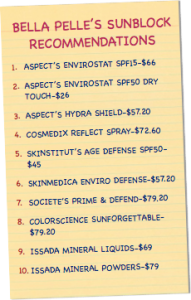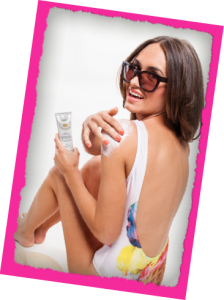We use sunscreen to block ultraviolet light or radiation from damaging the skin. There are three regions of ultraviolet light.
UVA-(aging rays) penetrates deeply into the skin and can lead to cancer and premature skin aging. This is what causes the long term damaging effects on our skin.
There is a lot of confusion out there about sunscreens and sunblocks. Around the world high SPF’s like SPF70 & 100 are hitting the market. The fair-skinned people of the world might be tempted to take this as an open invitation to slather some on, jump onto a lounge chair and bake for 12 hours thinking they will not get burnt. The higher the number, the better, right? Before you throw caution to the wind, though, you should know a few things about SPF. What is it, exactly? What do the numbers mean, and how high can they go??
SPF stands for Sun Protection Factor. This represents a time factor that you can use to help determine how long you can stay in the sun before getting a sunburn. The number next to the “SPF” on the bottle of your favorite lotion is a multiplication factor.
For example: If you can stay out in the sun 15 minutes before burning without sunscreen, then using a sunscreen with an SPF of 10 would allow you to prevent the burning for 10 times longer, so in this case for 150 minutes.
TESTING AND EXPOSURE TIME…
To determine a sunscreen’s SPF, testers round up (for example) 20 sun-sensitive people and measure the amount of UV rays it takes them to burn without sunscreen. Then they redo the test with sunscreen. The “with sunscreen” number is divided by the “without sunscreen” number, and the result is rounded down to the nearest five. This is the SPF.
To figure out how long you can stay in the sun with your sunscreen on, multiply the time you take to burn without sunscreen times the SPF number and that will give you the exposure time. HOWEVER- most people do not use enough sunscreen, or not equivalent to the quantity used when sunscreen testing occurs, therefore half that number, and it will give you a rough idea of when you should be reapplying.
PHYSICAL SUN BLOCK vs CHEMICAL SUNSCREEN… SPF numbers start at 2 and have just recently, in some countries, reached 100. In Australia, the highest approved SPF is 50. Now, when it comes to sunscreens & sunblocks (and yes, they are two different things), there are two different types. You have physical Sun Blocks, and Chemical Sunscreens.
Physical Sunblocks form a film or “physical barrier” over the skin where applied so that UV radiation is reflected away from the skin. These types of sun protectors are a total block because they prevent both UVA and UVB from damaging the skin.
Chemical Sunscreens absorb the harmful UVB light only, to protect the skin from burning but still let most of the UVA rays through. This absorption of the UVB rays actually creates extremely dangerous and active free radicals, therefore being toxic. Our body then needs to filter these chemicals as they can be absorbed into the blood stream, build up in the liver and be toxic if used over prolonged periods of time. This type of sun protector allows the UVA to penetrate deeper into the skin and are strongly adsorbed by the melanocyte cells in the skin (the cells that are responsible for the production of melanin or ‘pigment’) which then cause premature aging and cell mutation. By using these types of sunscreens we are still leaving ourselves open to photo damage & a variety of skin cancers such as malignant melanoma formation. The Therapeutic Goods Association here in Australia will not certify a non-chemical sunscreen as a SPF30 or higher unless it has certain chemicals in it. For this reason, you can not get a non-chemical Physical sun block in a 30+, they are only available in SPF15. A lot of consumers are very misguided when it comes to sun protection products and many believe that a SPF30 is double the protection of a SPF15. This is not necessarily the case. The percentage of UV rays blocked from the two most common Sun Protection Factors, that being SPF15 & SPF30 is very similar in number. An SPF15 blocks 94% of UV rays and a SPF30 Blocks 97% of UV rays.
THE INGREDIENTS THAT ARE THE PROTECTORS AGAINST THE SUN… In Physical Sun blocks the main ingredients used to protect against the UVB & UVA rays are Zinc Oxide (which protects 250-380nm) and Titanium Dioxide (250-400nm)
In Chemical Sunscreens the main ingredients are Aminobenzoic acid PABA (260-313nm), Octylmethoxycinnamate (270-328nm), Octyl Salicylate (300-310nm), Methylanthralinate (290-320nm), Oxybenzone (270-350nm), Dioxybenzone (260-380nm), Avobenzone (310-400nm)



No comments yet.